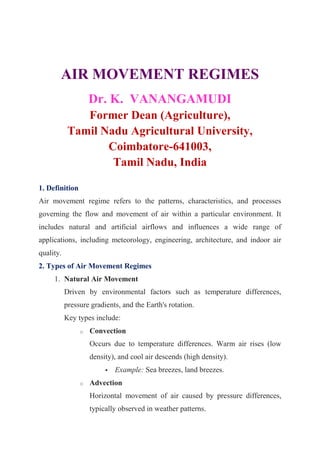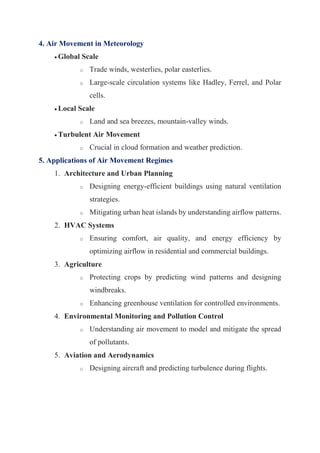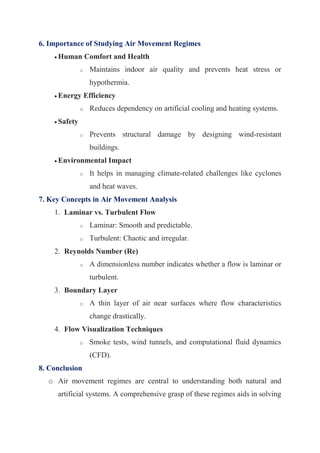AIR MOVEMENT REGIMES & ITS IMPORTANCE.pdf
- 1. AIR MOVEMENT REGIMES Dr. K. VANANGAMUDI Former Dean (Agriculture), Tamil Nadu Agricultural University, Coimbatore-641003, Tamil Nadu, India 1. Definition Air movement regime refers to the patterns, characteristics, and processes governing the flow and movement of air within a particular environment. It includes natural and artificial airflows and influences a wide range of applications, including meteorology, engineering, architecture, and indoor air quality. 2. Types of Air Movement Regimes 1. Natural Air Movement Driven by environmental factors such as temperature differences, pressure gradients, and the Earth's rotation. Key types include: o Convection Occurs due to temperature differences. Warm air rises (low density), and cool air descends (high density).  Example: Sea breezes, land breezes. o Advection Horizontal movement of air caused by pressure differences, typically observed in weather patterns.
- 2. o Turbulence Chaotic, irregular flow caused by obstacles (e.g., buildings, trees) or atmospheric instability. 2. Artificial Air Movement Caused by human-made systems to control airflow for specific purposes, such as HVAC (Heating, Ventilation, and Air Conditioning) systems. o Mechanical Ventilation Fans, blowers, or ducts that move air forcibly. o Controlled Natural Ventilation Using architectural designs like windows and louvers to optimize natural airflows. 3. Factors Influencing Air Movement Regimes 1. Temperature Gradients o Hot air rises and cold air sinks, creating natural convection currents. o Significant in phenomena like monsoons and thermals. 2. Pressure Gradients o Air moves from high-pressure to low-pressure areas. o Influences weather systems such as cyclones and anticyclones. 3. Obstructions and Obstacles o Urban structures like skyscrapers and mountains disrupt air movement, causing turbulence or wind shadowing. 4. Earth’s Rotation (Coriolis Effect) o Causes deflection of moving air, influencing global wind patterns like trade winds and jet streams. 5. Humidity and Moisture Content o Affects density of air and its buoyancy. o Impacts weather phenomena like thunderstorms.
- 3. 4. Air Movement in Meteorology ď‚· Global Scale o Trade winds, westerlies, polar easterlies. o Large-scale circulation systems like Hadley, Ferrel, and Polar cells. ď‚· Local Scale o Land and sea breezes, mountain-valley winds. ď‚· Turbulent Air Movement o Crucial in cloud formation and weather prediction. 5. Applications of Air Movement Regimes 1. Architecture and Urban Planning o Designing energy-efficient buildings using natural ventilation strategies. o Mitigating urban heat islands by understanding airflow patterns. 2. HVAC Systems o Ensuring comfort, air quality, and energy efficiency by optimizing airflow in residential and commercial buildings. 3. Agriculture o Protecting crops by predicting wind patterns and designing windbreaks. o Enhancing greenhouse ventilation for controlled environments. 4. Environmental Monitoring and Pollution Control o Understanding air movement to model and mitigate the spread of pollutants. 5. Aviation and Aerodynamics o Designing aircraft and predicting turbulence during flights.
- 4. 6. Importance of Studying Air Movement Regimes ď‚· Human Comfort and Health o Maintains indoor air quality and prevents heat stress or hypothermia. ď‚· Energy Efficiency o Reduces dependency on artificial cooling and heating systems. ď‚· Safety o Prevents structural damage by designing wind-resistant buildings. ď‚· Environmental Impact o It helps in managing climate-related challenges like cyclones and heat waves. 7. Key Concepts in Air Movement Analysis 1. Laminar vs. Turbulent Flow o Laminar: Smooth and predictable. o Turbulent: Chaotic and irregular. 2. Reynolds Number (Re) o A dimensionless number indicates whether a flow is laminar or turbulent. 3. Boundary Layer o A thin layer of air near surfaces where flow characteristics change drastically. 4. Flow Visualization Techniques o Smoke tests, wind tunnels, and computational fluid dynamics (CFD). 8. Conclusion o Air movement regimes are central to understanding both natural and artificial systems. A comprehensive grasp of these regimes aids in solving
- 5. problems across diverse fields, from weather forecasting and urban planning to energy conservation and environmental protection.




